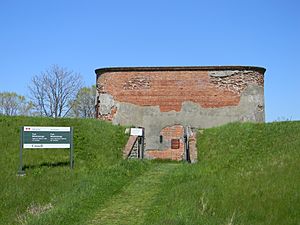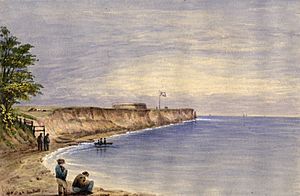Fort Mississauga facts for kids
Quick facts for kids Fort Mississauga |
|
|---|---|

Entrance to Fort Mississauga
|
|
| Location | Niagara-on-the-Lake, Ontario, Canada |
| Built | 1814 |
| Original use | Military fortification |
| Governing body | Parks Canada |
| Lua error in Module:Location_map at line 420: attempt to index field 'wikibase' (a nil value). | |
| Official name: Fort Mississauga National Historic Site of Canada | |
| Designated: | 30 May 1960 |
Fort Mississauga National Historic Site is an old fort located right on the edge of Lake Ontario. You can find it where the Niagara River meets the lake, in a town called Niagara-on-the-Lake, Ontario, Canada.
Today, the fort has a cool brick tower that looks like a box. It also has star-shaped earthworks, which are walls made of earth. This brick fort was built between 1814 and 1816 during the War of 1812. It was meant to replace another fort nearby, Fort George.
Workers built Fort Mississauga using bricks and stones from the ruins of a nearby town. This town, then called Newark, was burned by United States forces in December 1813. The new fort helped protect Upper Canada and was part of a group of forts. These included Fort George, Navy Hall, and Butler's Barracks. However, the fort was not fully finished until after the war ended.
Contents
History of Fort Mississauga
Early Days at Mississauga Point
Long before the fort was built, different First Nations groups lived on this land. The Neutral people were here in the 15th century. Later, the Seneca nation lived here in the late 1600s. The Mississauga people used the area in the 1700s.
In 1804, a lighthouse was built at this spot, which was known as Mississauga Point. This was the very first lighthouse on the Great Lakes! But it was taken down in 1814 to make room for Fort Mississauga. Some of its stones were even used to build the new fort.
Today, the Mississauga Point Lighthouse is a National Historic Site. A special plaque inside Fort Mississauga remembers this important lighthouse.
Building the Fort During Wartime
After the British captured Fort Niagara in December 1813, a group called Captain Runchey's Company of Coloured Men helped. They worked with the Royal Engineers to fix up forts near the Niagara River.
In the spring of 1814, this company was told to build a brand new fort on the Canadian side. This new fort was named Fort Mississauga. The building materials came from the damaged town of Newark.
At this time, the American navy controlled Lake Ontario. So, building Fort Mississauga was super important for the safety of British forces. One British officer said the fort "would prevent vessels coming up the river." Because they were busy building, the Coloured Corps could not fight in other battles that summer.
How the Fort Was Used
The British Army used Fort Mississauga from 1813 to 1855. After that, the Canadian Militia took over. They used it as a summer training area starting in the 1870s. Soldiers also trained here during both World Wars and the Korean War.
A golf course was built nearby in the late 1870s. Today, the Niagara-on-the-Lake Golf Course surrounds the fort. You can still visit the fort by walking on a special path. Just be careful and watch out for golfers, as they have the right of way! The path starts at the corner of Front and Simcoe streets.
The blockhouse is the only original building from the fort that still stands. Other buildings, which were mostly made of logs, were either destroyed or taken apart. You can't go inside the blockhouse, but you can see wooden stairs leading to some upper windows.
Fort Mississauga is a National Historic Site of Canada. It is one of several historic places in the Niagara area managed by Parks Canada.
See also
- List of forts
- Butler's Barracks
- Fort Erie
- Fort George
- Navy Hall


